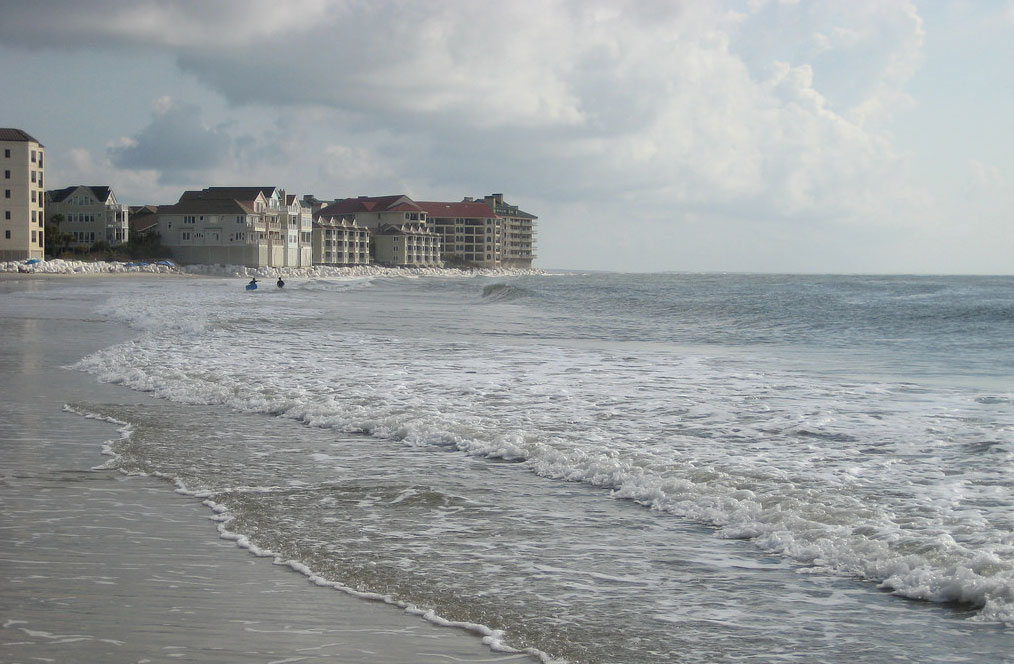
Sandbags and beach erosion, Isle of Palms, Charleston County, South Carolina. Photo source: ©© Maigh
Excerpts;
In South Carolina, beach renourishment is a never-ending job…
Read Full Article, Post And Courier (04-23-2017)
Coastal geologist criticizes beach renourishment efforts; By Robert S. Young, PhD; The State (08-17-2016)
Rob Young, who heads the Program for the Study of Developed Shorelines at Western Carolina University, said the government is subsidizing coastal development with renourishment money – and that’s costing taxpayers. Communities across the country have spent millions of dollars renourishing beaches. Those efforts encourage people to rebuild after every major hurricane…
Beach replenishment may have far reaching impacts on ecosystems;” Phys.Org (03-29-2016)
UC San Diego biologists who examined the biological impact of replenishing eroded beaches with offshore sand found that such beach replenishment efforts could have long-term negative impacts on coastal ecosystems…
Study: Sand nourishment linked to fewer marine life, Palm Beach Daily News (04-2016)
A recent study examining the impact of beach nourishment projects on marine life should provoke further research by local scientists, according to a Palm Beach Atlantic University biologist…
Economy Winner, Environment Loser in Renourishment; Pensacola News Journal (12-02-2015)
South Carolina says no to Wild Dunes beach erosion walls, Post And Courier (07-11-2016)
Experimental removable seawalls have been ordered to be taken down in front of erosion-imperiled condos and houses…
Seawall ‘Option’ Won’t Wash, Post And Courier (10-23-2014)
Hard erosion control devices aren’t generally allowed on South Carolina beaches, and with good reason. Here’s why: Seawalls actually can accelerate erosion, often on adjacent property. The failure of sandbags and other permitted devices speaks to the unrelenting forces of nature, not a shortcoming of the regulatory system primarily designed to protect the coast…
Sandbagging at the Shore: North Carolina’s Coastal Sand Bags and Political Sandbaggers; By William Neal, Orrin Pilkey & Norma Longo;
The wonder of modern English is how social use of language expands and changes the meaning of words. Sand bag is a bag filled with sand used for temporary construction—quickly made, easily transported, and easily removed. Typically, sandbagging is the emplacement of sand bags to construct a temporary protective wall or barrier, such as a dike or dam to hold back flood waters , or protection on the battlefield. But the term ‘sandbagging’ has taken on an array of other meanings…
Let’s end war with ocean, Op-Ed by Orrin H. Pilkey
The immediate future most certainly holds more miles of sandbags, resulting in more narrowed and ugly beaches.But this trend can be halted and reversed. Now is the time to make peace with the ocean.The time is now to stop sandbagging, both physically with no more shore-hardening structures, and politically with no more exceptions to the intent of the rules, no more undermining existing legislation, and a return to enforcement…
Rethinking Living Shorelines, By Orrin H. Pilkey, Rob Young, Norma Longo, and Andy Coburn;Program for the Study of Developed Shorelines / Western Carolina University, March 1, 2012, Nicholas School of the Environment, Duke University
In response to the detrimental environmental impacts caused by traditional erosion control structures, environmental groups, state and federal resource management agencies, now advocate an approach known as “Living Shorelines”that embraces the use of natural habitat elements such as indigenous vegetation, to stabilize and protect eroding shorelines.









